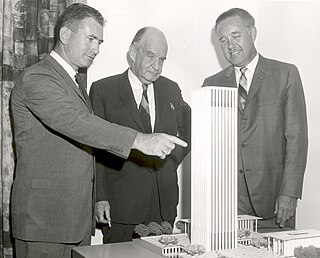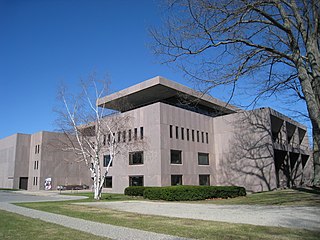
Edward Durell Stone was an American architect known for the formal, highly decorative buildings he designed in the 1950s and 1960s. His works include the Museum of Modern Art, in New York City; the Museo de Arte de Ponce in Ponce, Puerto Rico; the United States Embassy in New Delhi, India; The Keller Center at the University of Chicago; the John F. Kennedy Center for the Performing Arts in Washington, D.C.; and the EcoTarium, formerly known as the New England Science Center in Worcester, Massachusetts.

Moshe Safdie is an architect, urban planner, educator, theorist, and author. He is known for incorporating principles of socially responsible design throughout his six-decade career. His projects include cultural, educational, and civic institutions such as neighborhoods and public parks, housing, mixed-use urban centers, and airports. He also had master plans for existing communities and entirely new cities in the Americas, the Middle East, and Asia. Safdie is most identified with designing Marina Bay Sands and Jewel Changi Airport, as well as his debut project Habitat 67, which was originally conceived as his thesis at McGill University. He holds legal citizenship in Israel, Canada, and the United States.

Benjamin C. Thompson was an American architect. He was one of eight architects who founded The Architects Collaborative (TAC) in 1945 in Cambridge, Massachusetts, one of the most notable firms in post-war modernism, and then started his own firm, Benjamin Thompson and Associates (BTA), in 1967.

The Architects Collaborative (TAC) was an American architectural firm formed by eight architects that operated between 1945 and 1995 in Cambridge, Massachusetts. The founding members were Norman C. Fletcher (1917–2007), Jean B. Fletcher (1915–1965), John C. Harkness (1916–2016), Sarah P. Harkness (1914–2013), Robert S. McMillan (1916–2001), Louis A. McMillen (1916–1998), Benjamin C. Thompson (1918–2002), and Walter Gropius (1883–1969). TAC created many successful projects, and was well respected for its broad range of designs, being considered one of the most notable firms in post-war modernism.
Sarah Pillsbury Harkness was an American architect.

Peter Walker is an American landscape architect and the founder of PWP Landscape Architecture.
Joan Edelman Goody was an American architect based in Boston, Massachusetts, where she served on the faculty of the Mayor's Institute for City Design, and earlier as chair of the Boston Civic Design Commission. She was known for her influence in the latter part of the 20th and early 21st century on Boston modern architecture and historic preservation. She was also the author of several books on architecture, including an early work on the emerging modern style in Boston, New Architecture in Boston.

Arthur Rotch was an American architect active in Boston, Massachusetts.

The MIT School of Architecture and Planning is one of the five schools of the Massachusetts Institute of Technology in Cambridge, Massachusetts. Founded in 1865 by William Robert Ware, the school offered the first architecture curriculum in the United States and was the first architecture program established within a university. MIT's Department of Architecture has consistently ranked among the top architecture/built environment schools in the world.
Scott Johnson is an American architect. He is the co-founder and Design Partner of Johnson Fain, an international architecture, planning and interior design firm located in Los Angeles.
Elizabeth Whittaker is an American architect, designer and educator based in Boston, Massachusetts. She is the founder of Merge Architects in Boston and Associate Professor in Practice of Architecture at the Graduate School of Design at Harvard University.

Nader Tehrani is an Iranian-American designer and educator.
John Ronan is an American architect, designer and educator based in Chicago, in the United States. John Ronan FAIA is founding principal of John Ronan Architects in Chicago, founded in 1999.
Vincent George Kling was an American architect who co-founded the architectural practice KlingStubbins.

Adèle Naudé Santos is a South African-born American architect and urban designer focused on low-income housing, campus architecture, and socially conscious design. She is the principal architect of Santos Prescott and Associates, based in San Francisco and Somerville, Massachusetts. She served as the Dean of the School of Architecture and Planning at Massachusetts Institute of Technology from 2003 to 2014. She became a Fellow of the American Institute of Architects in 1996.

Doris Cole,, is an American architect and author. She was a founding principal of Cole and Goyette, Architects and Planners Inc. She is the author of From Tipi to Skyscraper: A History of Women in Architecture. which was the first book on women in architecture in the United States.
Roger Kutnow Lewis, FAIA, was an American architect and urban planner, and a professor of architecture at the University of Maryland, College Park, where he taught architectural design and other courses for 37 years, retiring in 2006. Also an author, journalist and cartoonist, Lewis wrote about architecture and urban design, and about how public policy shapes the built environment.
Mark G. Swenson is an American architect and founding principal of Elness Swenson Graham Architects Inc. based in Minneapolis, Minnesota.

George Thomas Rockrise, FAIA, ASLA, AICP was an American architect, landscape architect, and urban planner of Japanese and English descent based in San Francisco, California. During his career he practiced both nationally and internationally, had a distinguished career in public service, and received numerous honors and awards.

Robert Traynham Coles was an architect, educator, and social justice activist. Coles was the first African American to win the Rotch Traveling Scholarship awarded by the Boston Society of Architects, the first African American Chancellor of the American Institute of Architects (AIA), the first AIA Vice-President for Minority Affairs, and a founding member of the National Organization of Minority Architects (NOMA).












